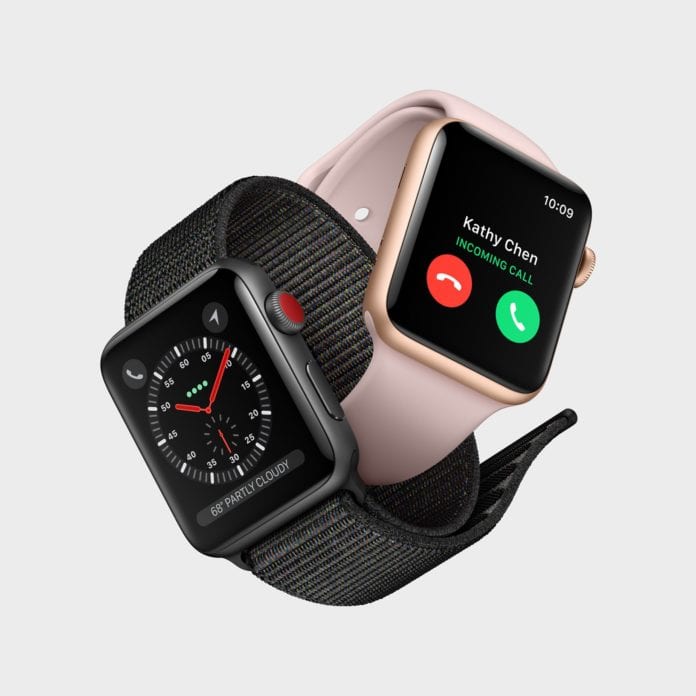Apple touts iPhone 8, iPhone X and a cellular Apple Watch
Apple continues to cater to the high-end smartphone customer, introducing its iPhone X (pronounced “ten”) yesterday with a price tag of a whopping $1,000 and going full Dick Tracy by enabling cellular connectivity on the new Apple Watch.
The price for the base model of new Apple devices continues to rise, with the iPhone 8 starting at $699 and the iPhone 8 Plus starting at $799 for the 64 GB models. The iPhone X starts at $999 for 64 GB and $1,149 for the 256 GB model. In addition to going all in on wireless charging on both the iPhone 8 models and the iPhone X, the iPhone X abandons a home button in favor of what is quite nearly an end-to-end front screen. Facial recognition replaces a fingerprint sensor. Still, investors appear mixed in the impact that the new devices will have and when. Apple stock was down more than 1.5% in trading Wednesday, due to the delay in the iPhone X sales (the device won’t be available for pre-order until late October and won’t arrive until November) — and the fact that there was a flub in the facial recognition demo, raising questions of how well it will work as a device unlocking mechanism.
Jeff Orr, research director at ABI Research, said that the new iPhone X “establishes a new value level for Apple customers that want a premium, futuristic device. A new price point is also implemented to reflect the flagship nature of iPhone X. A similar tiered smartphone offering already exists at Samsung, while other leading OEMs are expected to follow. This new class of iPhone affords Apple the opportunity to separate market and investor expectations. Low-cost iPhone solutions, such as the iPhone SE, can be prioritized for markets including India. iPhone X enhances the profitability for Apple smartphones, which will offset the downward price pressure and profitability at the low end of the market. Supply chain rumors have expressed concern that iPhone X is not yet yielding production volumes at similar levels to previous iPhone introductions. ABI Research expects supplies of the new premium models to be limited through 2017 and into the first half of calendar year 2018.”
It remains to be seen how consumers will respond to the new Apple offerings, but a survey of 200 people in the United Kingdom by Maru/edr just prior to the launch found that 43% did not plan to upgrade to Apple’s latest offerings — another 23% said they were unsure. Nearly 60% of those surveyed said that they expected the device would be too expensive, and 16% said that they felt the device wouldn’t be different enough from devices by other manufacturers.
In wearables, Apple is adding cellular connectivity to the Apple Watch for the first time, with the new models starting at $399 with both cellular and Global Positioning System enabled. The Apple Watch has both LTE and UMTS support, although in some cases UMTS support varies by carrier. All four national U.S. carriers will support the new Apple Watch, according to Apple’s web site, as well as Deutsche Telekom; China Unicom; EE in the United Kingdom; Telstra and Optus in Australia; Bell Canada; Orange in France; and NTT DoCoMo, Softbank and Au in Japan. Apple lists a number of carriers, including China Mobile and China Telecom, that are expected to support the device later this year. AT&T, Verizon and T-Mobile US all announced plans to charge $10 per month for customers to add Apple Watches to their data plans.
Loizos Heracleous, a professor of strategy at Warwick Business School who has researched Apple and its strategy, said that the move to introduce a $1,000 iPhone “is consistent with [Apple’s] business strategy of differentiation and exclusivity, targeting the higher end of the market rather than just aiming for a larger base of users. Given that the iPhone accounts for the majority of the company’s revenues and profits and its demand curve is relatively inelastic — i.e., a price change has less affect on sales — this pricing strategy makes sense in terms of revenue and profit growth.
“This move is also consistent with Apple’s image in important emerging economies as an exclusive handset and as the real thing, despite the availability of much cheaper imitations. While it may constrain rapid expansion of users, it strengthens the brand’s image and desirability as the mobile most people will buy when they are able to. …
“People have been predicting Apple’s demise for a while, but Apple’s performance has been growing stronger since Steve Jobs’ untimely departure. This pricing move is an example of the essence of strategy: being able to make tough choices that are meaningful for company performance. No move is risk-free, but as things stand, this seems like a courageous move that should turn out positively for the company in terms of performance, and create some distance from competing brands in terms of exclusivity.”

